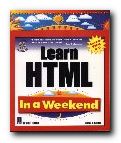step-by-step tutorials in HTML page design
Can you really learn HTML in a weekend? Well, Steve Callihan doesn’t make any rash claims. He only sets out in this beginner’s guide to cover the basics – leaving you to fill in the finer details with later practice. The book is written with the assumption that you have a relatively free weekend. You do some preliminary reading on Friday evening with some basics about hypertext and the basics of a web site. Saturday morning is devoted to the elements of HTML tags, how to create headings, paragraphs, and breaks. It’s organised to teach you what each code does and to give you an overview of HTML.
 Saturday afternoon is described as optional. It deals with some of the refinements of aligning text on the page, wrapping text round images, and dealing with font sizes, colours, and faces. If you have the stamina to keep going, Saturday evening is a ‘bonus’ session covering tables. Don’t take this timetable too seriously. Anyone who can master tables in one evening should apply immediately to the Nobel Prize Foundation.
Saturday afternoon is described as optional. It deals with some of the refinements of aligning text on the page, wrapping text round images, and dealing with font sizes, colours, and faces. If you have the stamina to keep going, Saturday evening is a ‘bonus’ session covering tables. Don’t take this timetable too seriously. Anyone who can master tables in one evening should apply immediately to the Nobel Prize Foundation.
Sunday morning is devoted to frames – perhaps a section which beginners can skip, because frames are no longer even thought to be a good idea by most web design theorists. The afternoon session on forms is likely to be far more useful, and the evening ‘bonus’ session on graphics will be even more popular. I followed this in detail, since I’ve never been strong on graphics, and it proved to be a straightforward tour through making 3D buttons with Paint Shop Pro.
The book is well illustrated, and there’s a CD with the usual array of free and shareware editors and browsers, so you have all that’s required here to make a start. It truly could be done in a weekend – but why not take a little more time and get it right.
© Roy Johnson 2000
Steve Callihan, Learn HTML in a Weekend, Rocklin, CA: Prima Publishing, 1999, pp.425, ISBN 0761518002
More on technology
More on digital media
More on web design
More on computers